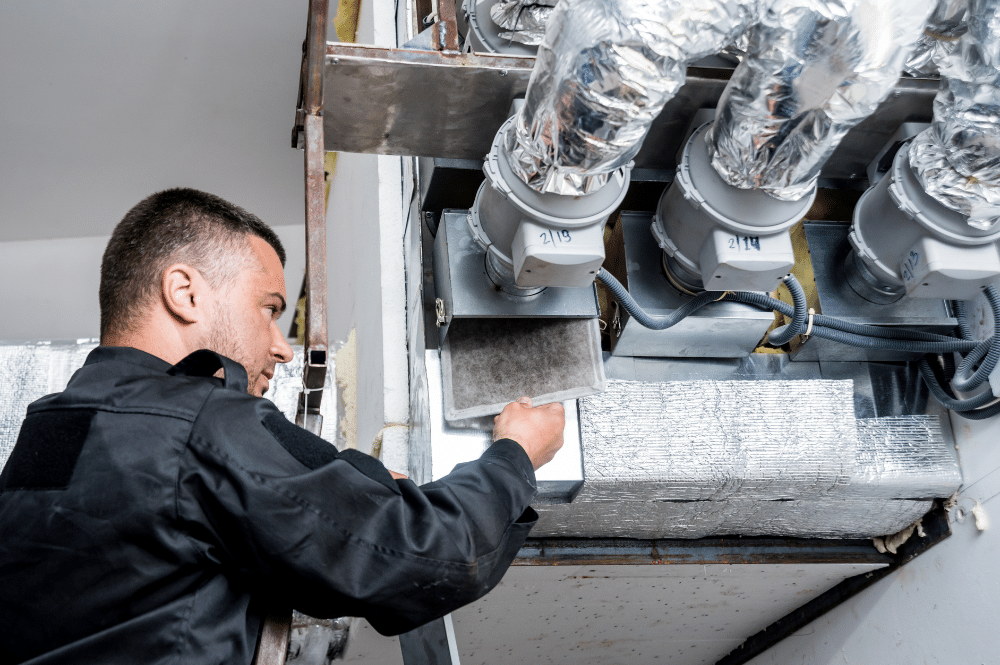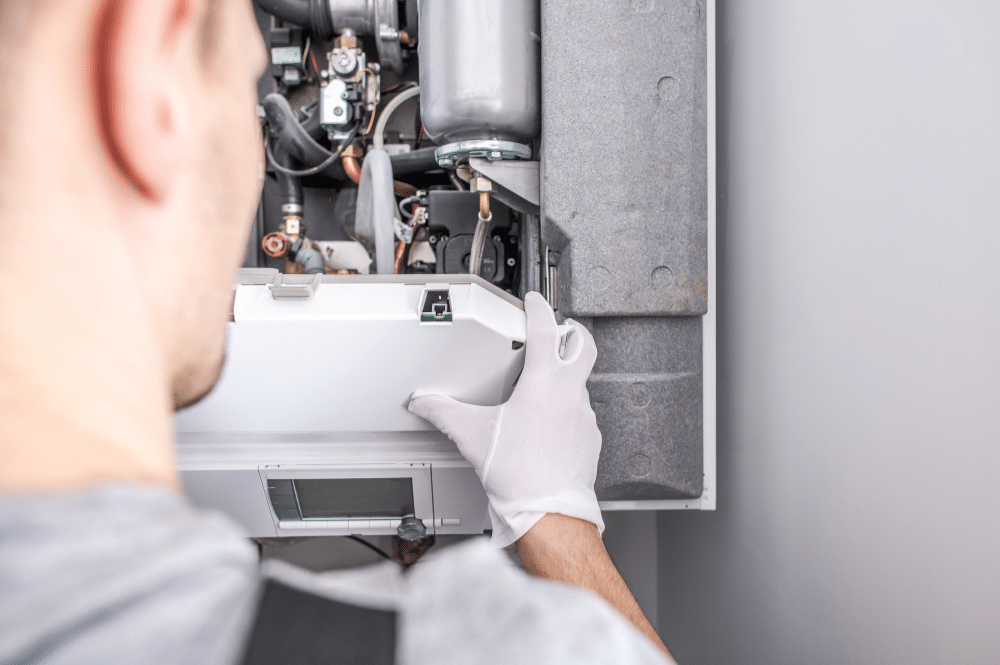You depend on your HVAC system to keep you cool all summer and warm all winter. You know that it faithfully starts right up as soon as the temperatures change, but are you aware of what’s really going on behind the scenes?
Beneath that boxy, metal exterior lies an intricate system of parts that all work in tandem to help keep your family comfortable all year long. Condensers play an important role in this system.
What does a condenser do and why is it important? What role do they play in your HVAC setup and how can you keep yours in top condition?
Today, we’re answering all of these questions and more. You’ll walk away with a newfound appreciation for all of the components that keep your home running, no matter how big or little they might be.
How Does An Air Conditioning System Work?
Before we dive into the in-depth details of condensers, it helps to understand how your air conditioning system works in the first place. This is a major part of your home or office that you may not give much thought to, but depend on greatly on a daily basis.
A standard HVAC system includes three primary components. These include an:
- AC furnace (electric or gas)
- AC condenser
- AC evaporator
The condenser and evaporator function as a system of coils, connected by a series of pipes that run between them. Part of the condenser, the compressor is a type of electric pump that is used to pressurize the gas inside of the unit.
Depending on the size and scale of your system, you’ll have other parts and accessories, too. For instance, many systems will also contain an expansion valve to help regulate and control the transfer of refrigerant as it travels into the evaporator coils.
In general, a large commercial HVAC system will look different from a small household window unit. However, nearly every system will include some variation of the above three components.
The method in which they work together, however, may vary.
For instance, in a central air conditioner, the condenser and compressor are usually located within the same unit, in a system placed on the exterior of the property. On the other hand, in a smaller window unit, the condenser is located on the back portion of the unit (rather than contained within the unit), facing the outdoors.
What Does a Condenser Do? Understanding the Process
The compressor, condenser, and evaporator are all part of a tightly sealed system that contains a non-combustible called refrigerant, or coolant. This is the cooling agent that actually generates the cool air inside of the system.
How does it work? The refrigerant undergoes a repetitive evaporation process that allows the system to produce cool air and circulate it throughout your AC system via a series of coiled refrigerant lines.
In all, this isn’t an overly complicated process. The condenser, however, plays a vital role in it.
First, the refrigerant gas enters the AC compressor. The compressor will compress these gaseous molecules, which makes them very hot. Now, the gas is operating under both high pressure and high temperatures, which causes the heat to start dissipating into the air.
Once it leaves the compressor, the gas will travel to the condenser through the series of condenser coils, which are usually made of copper. Within this condenser unit, there are also a series of fans, along with a set of metal fins.
Together, the fans and fins work to help remove the heat from the refrigerant gas as it travels through the coils. Before long, the gas cools down and converts from a gaseous state back into a liquid.
When this transformation happens, the refrigerant then travels to the interior portion of the HVAC system, where it contacts the system’s evaporator coils. Once there, it absorbs the surrounding heat, which effectively cools the air around the evaporator coils. Then, the fan in your unit helps spread this newly-cooled air throughout your home!
When this process is complete, the refrigerant converts back into a low-pressure gas. The cycle begins all over again as it travels back to the compressor. These steps will repeat as often as necessary until the air in your home reaches the temperature that you set on your thermostat.
Understanding the Condenser’s Role
Due to the fact that the condenser unit contains a fan that blows air, many people think that this component is the part of the HVAC system that pumps air into and out of their home.
However, as described in the process above, the condenser is strictly responsible for pumping refrigerant. The air that is blown from the condenser is generated by the fan it uses to cool itself. The actual condenser does not integrate into your home’s ductwork.
A Word on Freon
If you’ve been a homeowner or business owner for many years, you may refer to refrigerant by one of its most common commercial brand names: Freon, or R-22.
For decades, Freon was the go-to refrigerant used by teams of HVAC technicians around the country.
However, Section 608 of the Clean Air Act of 1990 revealed that while it might be effective, the gas isn’t ideal for the environment. In this Act, the U.S. Environmental Protection Agency (EPA) identified many different ozone-depleting substances (ODS) and their substitutes that could contribute to air pollution across the United States.
These included several synthetic chemicals, such as:
- Chlorofluorocarbons (CFCs)
- Halons
- Hydrochlorofluorocarbons (HCFCs)
Across various industries, these chemicals are used in different capacities. For example, you might find them as refrigerants, solvents, or even insulating foams.
In Section 608, the EPA specifically prohibits anyone from intentionally venting ODS refrigerants while maintaining, servicing, or disposing of air conditioning systems or any type of refrigeration equipment. This is part of the agency’s overall goal to reduce the use and emission of CFCs and HCFCs.
As Freon is a known HCFC, professionals in this space have been phasing it out of use, reaching for more eco-friendly alternatives instead. One of these alternatives is Puron, or R-410A. Approved by the EPA as an acceptable alternative to Freon, Puron is recognized by industry experts as the first long-term solution to help combat ozone depletion.
The refrigerant in your HVAC system should not dissipate. However, if you have even a tiny leak in your system, it could begin to leak refrigerant.
Most leaks can be traced back to a broken coil or a worn-out seal. When these issues happen, you’ll begin to notice that your air conditioning system is not working as well as it once did.
Notable System Variations
Do all of the components in air conditioning units work the same way for all models? Not quite. There are a few notable variations to understand. Let’s check out a few of the most common ones.
Window AC Units
If you’re tight on space or simply don’t want to contend with the costs and upkeep associated with a central air conditioning system, a window AC unit can be a viable alternative.
In this unit, all of the key components are packaged together into a small unit that is placed, as its name implies, in your window opening.
How is everything laid out?
In a window unit, the evaporator coils will be located close to the front of the unit, with the condenser coils moved to the back. Also on the back, you’ll find the unit’s vents. These allow hot air to escape from the condenser coil.
Split System AC Units
In a packaged HVAC system, the major components (evaporator coils, condenser, and compressor) are all housed together in the same unit. This saves space indoors, as the exterior unit is usually placed on a cement slab outside the structure, or sometimes on the ceiling of the home or commercial building.
With this setup, the exterior system ties into a system of specialty-made ductwork, which connects the outdoor cabinet to the packaged central AC functions that are all controlled indoors.
A split AC system, on the other hand, does not contain as many components outdoors. As such, it is usually reserved for spaces that have the room to house a larger-sized indoor unit.
With a split system, only the condenser and compressor will be located in the outdoor cabinet. Indoors, you’ll find another cabinet that houses the evaporator coil. Usually, the indoor system will be located in a basement or in close proximity to the home’s furnace or heat pump.
Within this system, an air handler works to send cool air through the building’s ductwork. Meanwhile, a special copper tube (known as a line set), connects the interior and exterior components and moves cold air to the whole house. The outdoor condenser unit helps eliminate the heat absorbed by the refrigerant.
In many cases, split systems can be more efficient than packaged HVAC systems. They’re also more customizable and usually require less maintenance than their counterparts.
Vehicular AC Units
While we’re discussing different types of AC units, let’s briefly touch on the one that you likely manipulate more than any other: the one in your car!
Your vehicle’s AC system works very similarly to the system in your home. In these, you’ll still find evaporators and condensers, though the arrangement will understandably look a little different.
In a vehicle, the AC condenser will be located near your engine radiator. You’ll notice that it includes metal fins that allow it to resemble a radiator. Yet, besides that form change, the system performs most of the same functions as the condenser in your home unit.
Is There a Problem With Your AC Condenser?
You shouldn’t have to wait until you’re in the throes of an AC unit breakdown to realize that there’s an issue with your unit’s condenser.
This is the key component that helps cool the refrigerant and convert it back into liquid form. It’s directly tied to the overall effectiveness of your system and without it, the other components are rendered useless. That’s why it’s important to keep it in top shape!
Scheduling regular preventative maintenance checks with your local team of HVAC technicians is a great way to stay on top of any problems and help reverse them before they turn into a bigger headache.
What could happen to your condenser unit to cause it to become damaged? There are a few issues that can occur with normal wear and tear. Over time, you might notice the following problems:
- Dirty condenser coils
- Clogged condenser coils
- Otherwise damaged condenser coils
If any of these red flags occur, you might not notice an immediate decline in operation. For instance, when your condenser unit isn’t up to par, the refrigerant may still be able to convert into a liquid and keep traveling through the rest of your AC system. However, if that refrigerant isn’t successfully cooled to the right temperature, the system will become less efficient and more susceptible to breakdowns.
High Energy Bill
Without a great-quality condenser, your overall HVAC system will have to work much harder to generate cool air and pump it throughout your home in order to reach your pre-set temperature. If you don’t feel the difference at once, you’ll notice it in other ways.
At home, the most obvious sign is a household energy bill that’s surprisingly higher than normal. You might not realize that your system is working much harder due to a breakdown at your condenser unit. If the issue occurs in your vehicle, this decreased output will result in lower fuel efficiency, causing you to use more gas and fill up more often.
Lack of Cool Air
Of course, one of the first, most important warning signs to look out for when you’re concerned about the quality of your condenser is a lack of cool air.
If you’ve started to notice that your home or car takes longer to feel cool or simply doesn’t feel as refreshing as it once did, it might be time to give this component another look. While a faulty condenser could be to blame, it’s important to understand that you might also be experiencing a refrigerant leak.
As mentioned, these can occur if there’s even a tiny crack in your evaporator unit or condenser coil. Due to their small size, these leaks can be very difficult to find and fix, and many HVAC technicians will recommend replacing a cracked coil or condenser unit rather than repairing it or patching it.
Leaks and Noises
Other times, the issues with your condenser will be more visible and obvious.
If you notice a lot more fluid pooling up around your HVAC system than usual condensation would create, this could point to a problem with your unit. The same holds true if you’ve been hearing loud, unusual noises coming from your unit!
Keeping Your AC Condenser Unit in Top Condition
Now that you know what can happen if there’s an issue with your condenser unit, what are some of the steps you can take to make sure yours stays in top condition?
Protecting your condenser unit isn’t overly difficult. However, your best course of action is to always allow a professional team of technicians to take a look at your systems. While there are plenty of online tutorials and resources designed to help you perform your own repairs, you could ultimately end up causing more harm (and spending more money) if your attempts to correct an issue do not go as planned.
If you’re in the Austin area, our team is your go-to resource for residential A/C and heating services, as well as commercial HVAC-R services. We also provide a range of refrigeration, air filtration and cleaning services, as well as 24/7 maintenance and repairs.
In the meantime, let’s take a look at a few of the ways you can help make your condenser lasts for years to come.
Maintaining Your Vehicular AC System
To keep your vehicle’s AC condenser in great shape, remember to follow your car’s recommended service schedule.
When you take your car to a reputable local dealership or body shop, their inspections should be thorough and will include checks on all of your major engine components, including your vehicular AC system.
Maintaining Your Window AC Unit
Is your AC system a window unit? If so, you have a few special considerations to keep in mind.
First, it’s important to monitor weather conditions. While your unit should be weather-resistant and capable of withstanding the elements, you want to take measures to expose it to as little moisture as possible.
Even if it’s muggy, try to avoid running your window unit during a heavy rainstorm. Doing so could cause moisture to enter the condenser. Over time, this can lead to corrosion. When this occurs, your unit will become more vulnerable to cracked coils and refrigerant leaks. While minor rainfalls are fine, try to avoid using your unit if you know a severe storm is on the way!
Maintaining Your Split or Packaged HVAC System
What if you have a split HVAC system or a conventional packaged model? In both cases, it’s best to allow a professional service team to inspect and maintain it on a regular basis.
When they do, check to make sure that they examine all of the system’s major components. In addition, they should also check your refrigerant levels. Beyond these steps, there are not too many special actions to take to keep your condenser working as it should.
One preventative step that can help tremendously? Every so often, take a look all the way around your outdoor HVAC unit. Make sure there are no grass clippings, leaves, twigs, or any other form of yard debris that could enter your unit or interfere with its operations.
In both commercial and residential units, it’s not uncommon for home or business owners to plant bushes, shrubs, or trees around their units as a natural means of concealment. As long as they’re placed far enough away not to interfere with the unit, this is a fine practice.
However, if they become overgrown or begin to encroach on the space, take the time to trim them back. Especially during the fall season, you may notice berries or nuts near your units, and flower blooms tend to fall toward the springtime.
All of these could enter the condenser and impede its operability. While an HVAC system cover can help protect them temporarily, these are not suggested for long-term use, as they can trap moisture.
Get the Most Out of Your HVAC System
Whether the temperatures are climbing up or falling down, a high-performing HVAC system is a must-have for any home or business.
While you might not fully understand how every single component works, you’ll surely notice when one malfunctions or begins to wear. That’s why it’s smart to learn as much as possible about the major parts and how they all work together.
What does a condenser do? In short, it’s the mechanism responsible for pumping and cooling the refrigerant in your unit. It allows this gas to perform its job and effectively cool your space. When it works as it should alongside the compressor and evaporator, you can enjoy a comfortably cool building, set to your exact specifications.
Want to keep your compressor running as it should? Looking to maximize and take control of your HVAC system in general? Our team is here to help.
We’re HVAC experts happily serving the greater Austin area. Get in touch with us today to schedule a visit!




